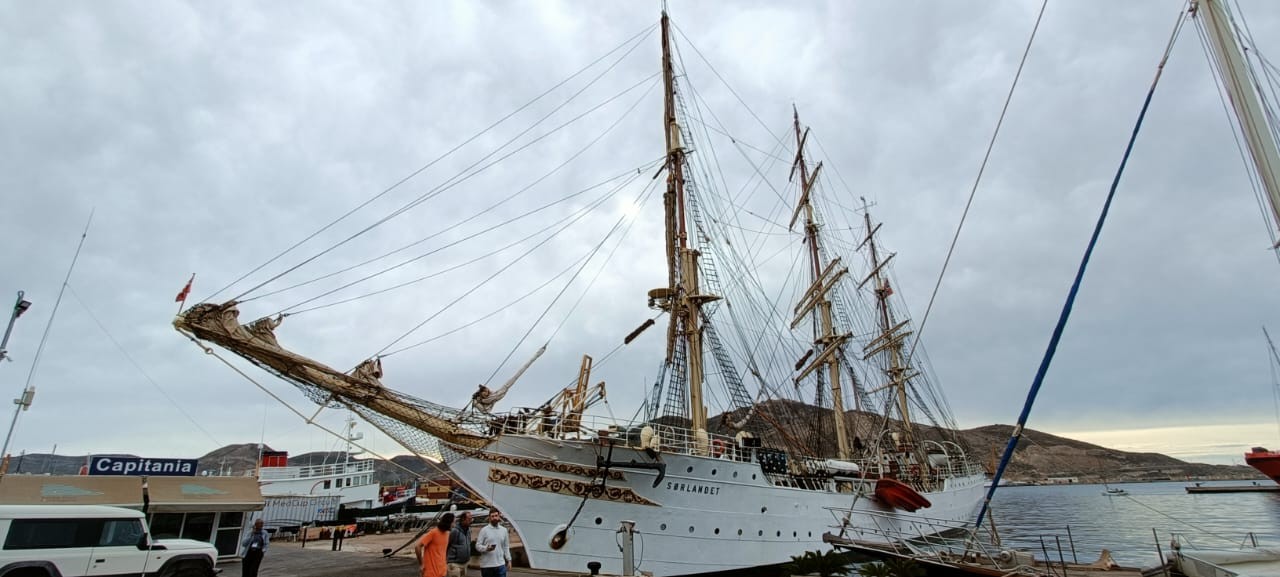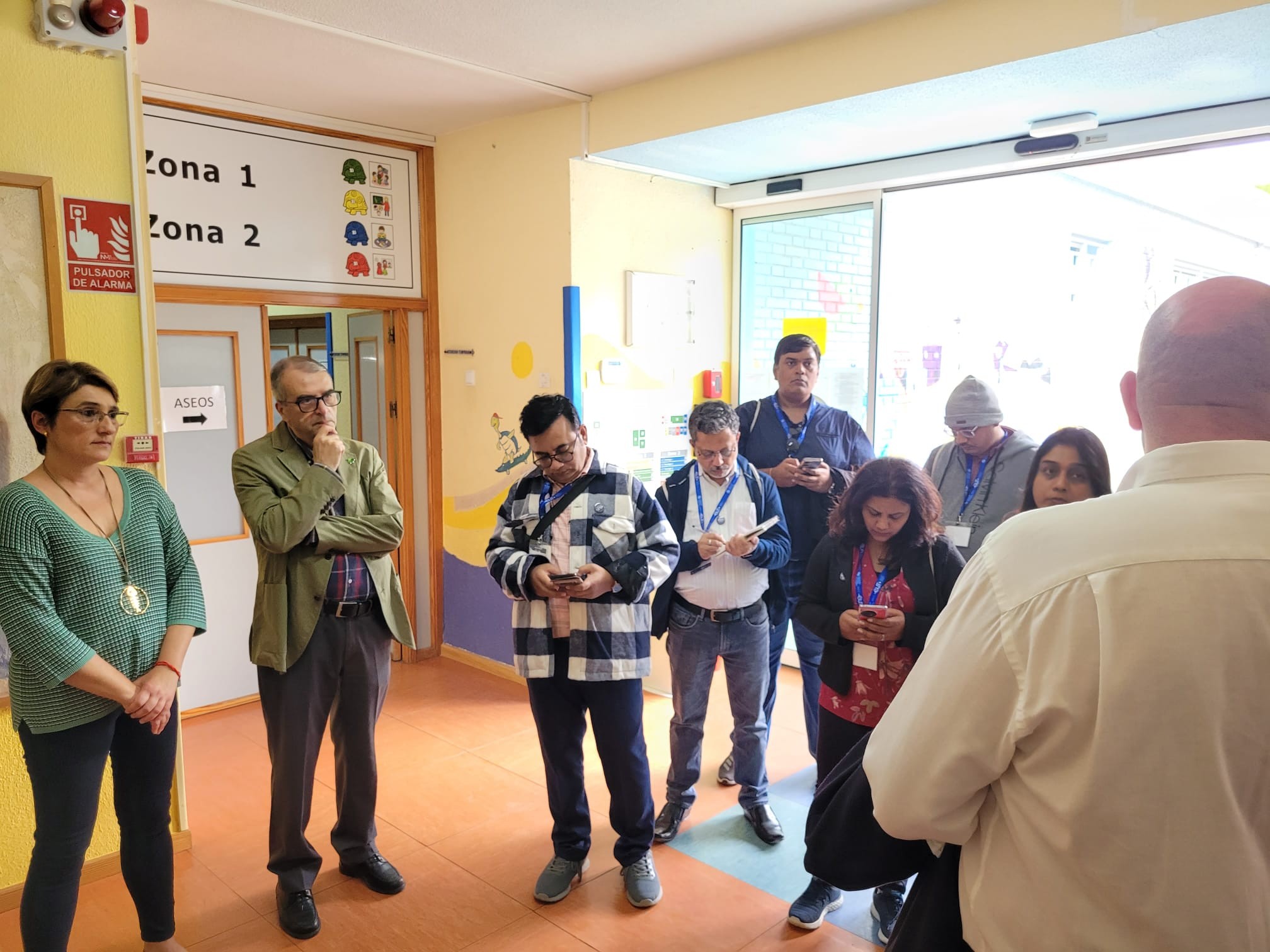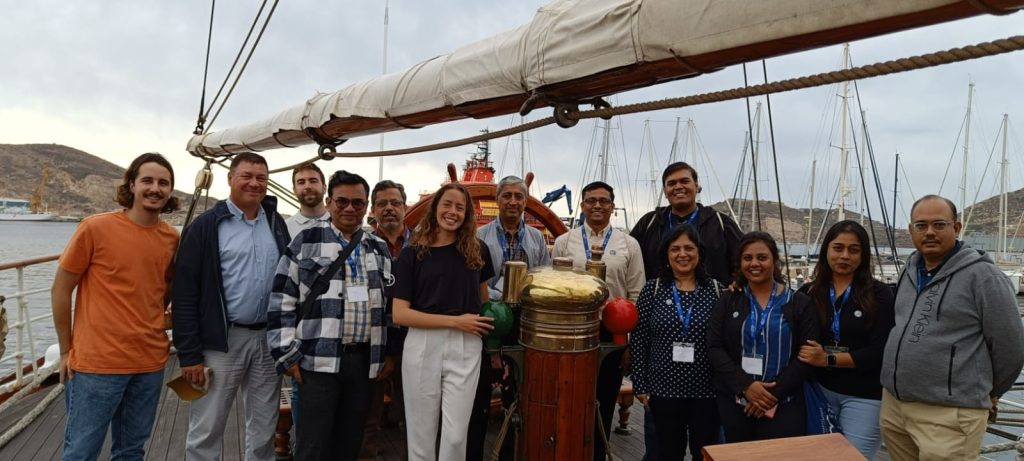Sailing Towards Inclusivity: Aboard the Sørlandet and Engineering Excellence in Mechanical Education
On October 27, the team went through the following two activities:
- A guided tour of the Norwegian floating school, the tall ship Sørlandet
- Seminar on “Inclusion in Mechanical Engineering Education” by Mr. Manuel Estrems Amestoy
Sørlandet
We reached the ship, now docked at Cartagena, at 9:40 am with Mr. Joaquín Francisco Roca González, Mr. Rafael Hernández Arnaiz, and Mr. Salvador. There, we were welcomed by Ms. Dani Rigual, who is part of the ship’s admissions crew for the A+ World Academy that runs the high school on board the Sørlandet, and got to experience firsthand how inclusivity, equity, and diversity become more than just words; they are woven into the very fabric of education and life on the open sea.
Breaking Barriers in Maritime Training
Sørlandet, built in 1927, was initially designed to train sailors in Norway. Today, it stands as a pioneer, having broken the barriers of traditional maritime training. What makes it truly exceptional is its commitment to gender equality; it was the first training ship in the world to welcome women into maritime training.

A Global Classroom Afloat
Sørlandet is no ordinary school; it is a floating classroom that embarks on extraordinary journeys. With students hailing from nine different nationalities, including Norwegian and Danish, it is a microcosm of the global village. This diversity provides a profound experience, both academically and personally, as students from around the world come together to learn.
Embracing Unique Living and Learning
One of the most distinctive aspects of this educational voyage is communal living. Students sleep in hammocks and live on board for 10 months, with a brief 10-day hiatus to visit their families. They learn to manage emotions, adapt to new surroundings, and bond with their shipmates.
The Daily Life on Sørlandet
Every day starts on the aft deck at 8 a.m. The ship is divided into eight groups of students, with each group responsible for specific tasks. There are 215 lines on the ship, and students are expected to learn the intricacies of all of them.
One noteworthy feature is the absence of mobile phones during sea voyages. Internet access is available, but it’s not always reliable, encouraging students to connect with their surroundings and shipmates.
The Value of Community and Service
Service is an integral part of life on Sørlandet. Students engage in community service, creating projects that continue even after the ship has sailed to new horizons. This not only enhances their sense of responsibility but also instills in them a profound awareness of their global impact.

Inclusivity and Safe Spaces
Sørlandet is not just a school; it’s a community where inclusivity and the creation of safe spaces are paramount. Nooks were initially designated as safe spaces for women, but today, they are a part of the overall living space. This change reflects the school’s commitment to evolving with the times and ensuring that every student feels at home on board.
The ship has adapted to the changing times, and this adaptation reflects its commitment to inclusivity and equity. By transforming previously gender-specific spaces into communal areas, Sørlandet reinforces the principle that every student’s voice and presence matter.

Seminar by Mr. Manuel Estrems Amestoy
At 1:00 pm, the team converged in the CPCD Workspace at ELDI with Mr. Rafael Hernández Arnaiz to attend a seminar on “Inclusion in Mechanical Engineering Education” by Mr. Manuel Estrems Amestoy, the Director of the Department of Mechanical Engineering, Materials, and Manufacturing at UPCT, who has under his tutelage many students with functional diversities as well as cognitive challenges such as Asperger’s Syndrome, and in whose class these students discover their hidden potential and ability to make a difference in the world of engineering. Described below is the process Mr. Amestoy utilises for inclusive teaching and learning in mechanical and design engineering.
Competing on a Global Stage:
Mr. Amestoy’s class at UPCT regularly participates in various engineering competitions where they can apply their engineering skills and knowledge of the subject matter. He ensures that ten students actively engage in five national and international engineering competitions:
- Formula SAE
- Motostudent
- Remote Operated Vehicle (ROV) Competition
- Solar Race Team
- Drone Team
In addition to the above teams, there is also a Makers team.
Fostering Engineering Excellence:
Mr. Amestoy’s approach includes providing comprehensive training to his students, such as:
- SolidWorks: A computer-aided design (CAD) and computer-aided engineering (CAE) programme.
- Fused Deposition Modelling (FDM): A 3D printing technology for rapid prototyping.
- Manufacturing Skills: Practical knowledge of manufacturing processes.
This training is not sporadic; it takes place once a week, providing four hours of focused learning. Inclusivity, in this context, is about providing the resources and support necessary for students to thrive. It’s important to note here that the students only work on projects for two years at a time. This timeline is crucial, as they need to finish their studies on time. Their calendar includes key phases:
- Training: building their skills and expertise.
- Development: conceptualising and designing engineering solutions.
- Manufacturing: bringing their designs to life.
- Testing: ensuring the reliability of their projects.
- Fundraising: securing the necessary resources for competition.
- Competition Attendance: Participating on a global stage.
- Plan in Two Years: Aligning their projects with their academic timeline.
- Intergenerational Transmittance: Passing on knowledge and experiences to future students.
Objectives Beyond the Classroom:
The objectives of these competitions extend beyond academic achievement:
- To Make Students Truly Feel Like Engineers: These competitions provide real-world challenges that instill a sense of engineering identity.
- Stimulate Creativity Through Challenges: Facing challenges head-on encourages students to think creatively and innovatively.
- Relevant Skilling: Competitions enhance their skills, making them job-ready.
- International Experience: Students gain exposure to global perspectives.
- Substantial Contribution to the Curriculum: Their experiences contribute significantly to their academic profiles.
- Contact with Companies: Industry Relationships: The real-world connections they make enhance their employability.
- Employability Level Enhancement: Students become technically valuable and secure positions in technical roles.
- Free Configuration Credits and Final Year Projects (PFC): Their participation leads to academic advantages.
A Holistic Learning Process:
Mr. Amestoy’s educational approach follows a well-defined process: Concept > Design > Production, complemented by planning, critical analysis, prototyping, testing, and production. The outcomes of this approach are profound:
- For Students:
- Competencies: They gain a deep understanding of engineering concepts and practical skills.
- International Experience: They develop a global mindset.
- Visibility of Curriculum: Their achievements enhance the visibility and reputation of the academic curriculum.
- Employment: The skills and experiences they acquire increase their employability.
- For Professors:
- Knowledge of Students: Professors gain insights into students’ abilities and potential.
- Learning with Doing as Engineers: Practical applications enhance the learning experience for both students and professors.
- Improving Classes: Professors can adjust and improve teaching methods based on real-world applications.
- Efficient Transmission of Values: Ethics, Veracity, and Human Rights: Real-world experiences help instill values and ethics in students.
-
Transition to Design Engineering:
Mr. Amestoy explained that when the programme undergoes any relevant transition from mechanical engineering to design engineering, it makes several optional courses mandatory, including:
- Manufacturing of Prototypes
- Manufacturing of Prototypes II
- Quality Engineering
- Additive Manufacturing
- Welding Engineering
- Advanced Manufacturing Technologies (CNC)
For courses like additive manufacturing, welding engineering, and advanced manufacturing technologies, traditional exams have been replaced by project-based assessments, highlighting:
- Details in Methodology: Students gain a deep understanding of the methods used in engineering.
- Scoring Difficulties: Challenges in scoring assessments encourage students to think critically.
- Work Distribution: Group projects uncover hidden talents among students.
- Peer-to-Peer Learning: Collaboration and project-based assessments encourage students to learn from one another.
Leveraging Technology and Collaboration:
UPCT ADM Technologies employs various technologies to support their education. This includes:
- Fused Deposition Modelling (FDM) is the primary technology used for competitions due to its universal applications.
- Stereolithography is a 3D printing technology used for rapid prototyping and manufacturing.
- Metal Printing: Although primarily used for demonstrations, it adds to the learning experience.
Additionally, UPCT collaborates with UC San Diego to create an interactive docent tool called CADI. This tool enhances the learning experience by providing opportunities for students to engage with an interactive platform.
Mr. Amestoy’s class at UPCT exemplifies how inclusivity, equity, and diversity can drive excellence and innovation in mechanical engineering education. It shows that every student can shine, regardless of their background or abilities, when given the right opportunities and support.